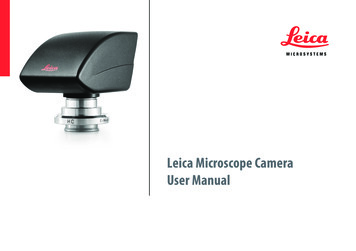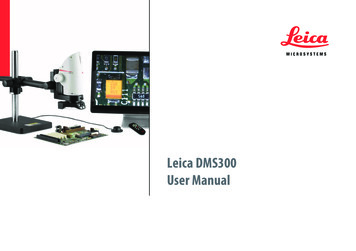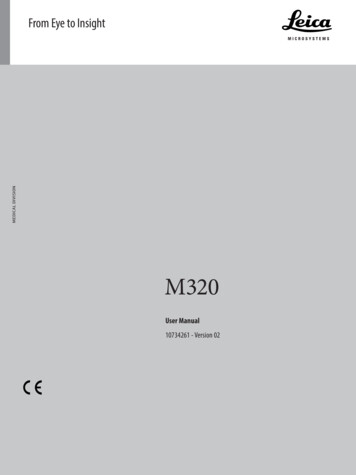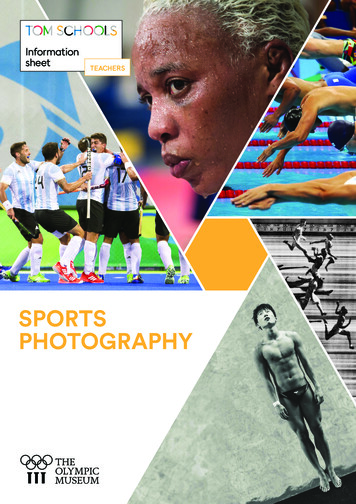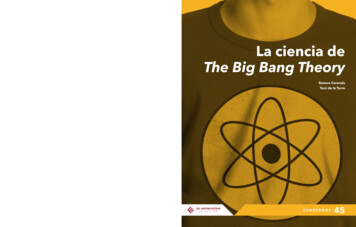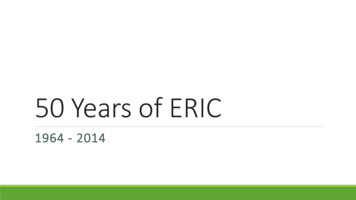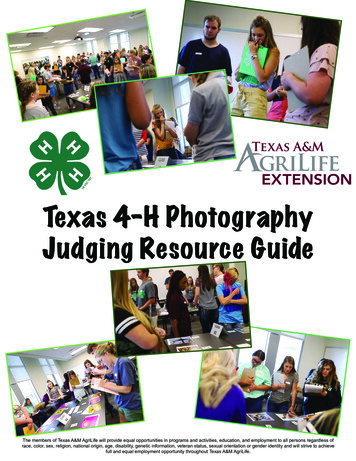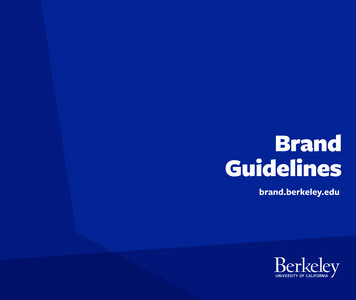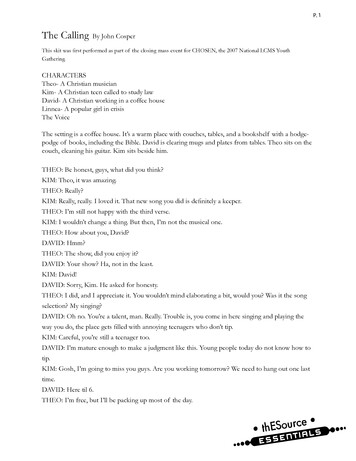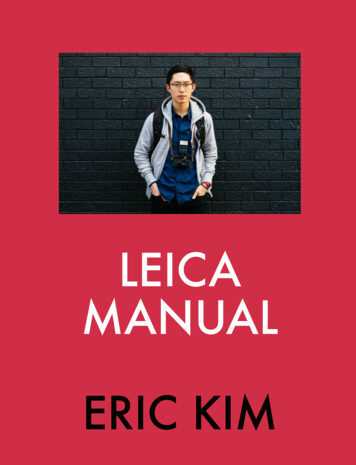
Transcription
LEICAMANUALERIC KIM
IF I HAD A LEICA, ALL OF MY LIFE’SPROBLEMS WOULD BE SOLVEDWhen I first started street photography, I used abulky DSLR (Canon 5D). I always thought thatbuying a Leica, I would become a much betterstreet photographer. I fantasized about the lookof the camera, the lightness and compactness ofthe camera, and the ease of use. I imagined myself shooting with a Leica on the romantic streetsof Paris, in the foots of Henri Cartier-Bresson.One of my dreams in life was to own a Leica.And when I finally got one (a Leica M9) — Ithought I would be happy for the rest of my life.Wrong.After about a month of owning it, the appeal andnovelty wore off— and it started to collect (asmuch dust) as my Canon 5D did on the shelf.less obtrusive, and the camera shutter was moresilent. It didn’t.I thought that buying the Leica would help memake better images, because it was quicker andmore discrete. It didn’t.I thought that buying the Leica would make mesatisfied for the rest of my life, because it was the“best” gear that money could buy. It didn’t.Soon after buying the Leica M9, I got the filmbug. My good friend Todd gave me his film LeicaM6. I fell in love. I never touched the M9 afterthat.I eventually ended up selling the M9, and tradingit for a film Leica MP.I thought that buying the Leica would make me amore confident photographer, because it wasi
But nowadays most of my photography is shooting with a small compact camera for street photography (Ricoh GR II). I prefer the smaller size— it is easier to carry with me everywhere I go, itis cheaper (so less anxiety about losing it), andeven less obtrusive.Whenever I miss a shot on a Leica or rangefinder, I never blame my camera — I can onlyblame myself.I still think the Leica is a fantastic camera forstreet photography, and don’t discourage anyone from investing in one. My suggestion is tojust be realistic with yourself.Buying a Leica won’t change your life. It won’tmake you a better photographer, nor a more confident photographer.But shooting with a Leica is certainly a differentexperience than using a DSLR or a traditionalcamera.A Leica (or rangefinder) has fewer functions,fewer menus to deal with, and therefore is moreminimalist and less complicated (in that sense).Sketch of my Leica MP by Phillip KimWith a Leica (or rangefinder) — the operation isvery simple. All you have to do is change the focusing distance, the aperture, shutter-speed,and ISO. And all of these settings are easily accessible, without having to dig through menus.Also a Leica is far smaller and more compactthan bulky DSLR’s (although not necessarilylighter).If you want the ultimate speed and responsiveness in a camera, honestly you can’t beat aLeica or rangefinder. Why? Because if you employ “zone focusing” (pre-focusing to a certaindistance, and using a small aperture like f/8-f-16)you will never miss the “decisive moment.”ii
13 COMMON LEICA MISTAKESEverything I will share in this manual is based on my personal experiences. This is the information Iwish I knew if I started shooting with a Leica or rangefinder all over again.To start off, common mistakes that I made, or things to avoid.1. DON’T SHOOT WIDE-OPENIf you see on the internet, almost everyone talks about how amazing it is to shoot wide-open on aLeica (with Leica lenses). They lust after f/1.4 lenses, and even the legendary f/.95 “Noctilux” lens.But that isn’t what the Leica or rangefinders were designed to do.3
In the early days of photography, the “fastest”lenses were limited to f/3.5. The concept of shooting “wide-open” at f/1.4, f/1.8, or f/2 was unheardof.f/8-f/16). Therefore whenever they clicked and hitthe shutter (with their 28mm or 35mm lenses),they would capture “the decisive moment” in images that were both sharp and in-focus.Rather, what most photographers did with theLeica (most of them being street, documentary,or photojournalists) was to shoot at f/8-16. Thisallowed them to have more depth-of-field, so thatthey were more likely to have an in-focus image.The downside of shooting wide-open (at least instreet photography) is your likelihood of gettingan in-focus image is very slim. There are somepeople who can do it— but why risk it?Furthermore, early practitioners in street photography (like Garry Winogrand and Joel Meyerowitz) would shoot black and white film (pushingthe ASA/ISO to 1000 ). This would allow them tomax-out their shutter-speeds on their film Leicas(to 1/1000th of a second, while shooting betweenFurthermore, I think a truly great street photograph needs both an interesting subject andbackground. By shooting wide-open (at f/1.4-2)means your background gets totally blurred out.And then you lose context, interest, or depth inyour street photograph.4
If you look at the best street photographs in history, almost all of them have a relatively deepdepth-of-field. You can see the foreground, middle ground, and background.Shooting wide-open (f/1.4-2) is necessary ifyou’re shooting at night, in dark situations, without a flash. Or it might be good if you’re trying tomake some nice portraits of models, or of afancy wine glass.But if your interest is in shooting street photography, keep your aperture to a default of f/8. Thegood thing about f/8 is that it allows enough lightto enter your camera, and gives you a good balance of depth-of-field.f/16 works well on really bright days, but if you’reshooting in the shade, I recommend sticking at f/8.2. DON’T SHOOT WITH A50MM LENSThis point might be a bit more controversial:many people who first get a Leica buy a 50mmlens because that is the lens that Henri CartierBresson shot with.I don’t want to poo-poo the 50mm lens too much.It is good for flattening your perspective, it isnice for portraits, and easier to frame and compose with.5
However I think in today’s modern world, wherethe streets are much more crowded, a 50mm isjust too tight. There isn’t enough space in mostcities to shoot with a 50mm lens.I recommend a 35mm lens for most street photographers starting off shooting with a Leica orrangefinder.Why?A 35mm lens is the best “good enough” lens onthe streets. It isn’t too wide (like a 28mm lens)nor is it too close (like a 50mm lens). Apparently Ialso read that the human eye sees the worldfrom roughly a 38-40mm perspective. And I feelthat having a 35mm affords you a little more flexibility.If your back is against the wall, you cannot takea step backwards. But you can always take astep forward.If you become more advanced in street photography, a 28mm is also a good lens. Yet the problemwith a 28mm lens for street photography is thatyou need to get really close. And most beginnersaren’t that comfortable shooting that close. Furthermore, if you wear glasses (like I do) you cannot fully see the edges of the frame lines on a28mm lens (assuming your Leica has the defaultmagnification of .72).6
A random tip, if you want to shoot with a 28mmlens (and you have glasses) try to get a Leicawith a .58 magnification (allows you to see moreof the frame lines). Unfortunately Leicas with a.58 magnification are only film ones— not digitalones.3. DON’T JUMP HEAD-FIRSTINTO A DIGITAL LEICADigital Leicas are far more expensive than theirmore affordable film counter-parts.Therefore if you are unsure whether shooting witha Leica or rangefinder is right for you, I’d recommend starting off with a cheap film rangefinder,or a film Leica.A good cheap rangefinders to start off with is aYaschica Electro 35.The best “bang for the buck” film Leica to startoff with is a Leica M6 (which has a meter-built in).Cheaper film Leica’s you can start off with include the Leica M4 (built like the M6, but doesn’thave a meter) and Leica M5 (body styling is different, but still a good camera).If you don’t want to bother with film, want a Leica,and might be more on a budget— I’d recommend a second-hand Leica M8 or Leica M9 (forthe rangefinder ‘experience’).The Leica M8 is great for shooting black andwhites (but horrible for color). The Leica M9 isgreat for shooting both black and white andcolor, but if you want nice colors you can’t shoot7
above ISO 400 (black and white I shot with it allthe time at ISO 2,500).cameras really suck. And the ISO performance isquite poor.What is the difference between the Leica M8 andLeica M9 from the more modern “Leica M” (240)variant? The main difference is the sensor— theolder M8 and M9 have a “CCD” sensor (peoplesay the colors and black and white files lookmore like film, but the high-iso performance isworse). The new Leica M240 has a “CMOS” sensor (same as DSLR’s, which have better high-isoperformance, but people say the colors andblack and whites look ‘flatter’ in contrast compared to the CCD sensors).Personally, I prefer the Leica M8/M9 over themodern digital Leica. Why? They are slightlysmaller in size, which feels better in the hand. Ialso think the files from the CCD have a moreunique “look” or colors to them. This is definitelypersonal preference, but I find the new LeicaCMOS sensor to not have as much vibrancy inthe color files.Also, the Leica M8 and Leica M9 are a bit frustrating to shoot with. They have slower “buffers”(which means, after taking 5-10 photos, yourcamera freezes, and it ‘writes’ the files to yourmemory card). Also the LCD screens on theseBut the new digital Leica has many benefits. It ismuch faster to shoot with, more responsive, andhas a quieter shutter sound.Whatever you decide to invest in, I recommendrenting one or just trying it out. A lot of peoplefantasize about buying a Leica or rangefinder,only to find out they prefer autofocus.8
2HOW TO SHOOT ON A LEICAOkay, so let’s say you get either a film or digital Leica, with let’s say a 35mm lens.Now the tricky part— how do you shoot with it?If you have a film Leica or rangefinder, I recommend reading my book: “The Film Photography Manual” where I have covered technical settings on shooting street photography on film in detail.If you have a digital Leica or rangefinder, let’s move on:STEP 1: SET YOUR CAMERA TO APERTURE-PRIORITY (OR A)MODEIf you have a digital Leica, I recommend shooting in Aperture-priority or “A” mode.9
Why? It means you have one less thing to worryabout.By putting your camera in aperture-prioritymode, your camera will automatically choose theshutter-speed.Then choose your aperture to f/8 as a default.STEP 2: SET YOUR ISO TO1600-3200Secondly, you want to not use automatic-ISO. Because that will default your shutter-speed tosomething slower.If you’re shooting street photography and havemoving subjects, you want your shutter-speed tobe at least 1/250th of a second. Preferably, if youwant really sharp street photos, you want yourshutter speed to be at least 1/1000th of a second.By putting your ISO to 1600 (or above), you willachieve a shutter speed of at least 1/250th of asecond during the day (assuming you’re shooting at f/8).At ISO 1600 (during the day), your shutter speedwill be around 1/250th of a second if you’re shooting in the shade. It might also drop to 1/125th ofa second (if you’re in really dark shade).Whenever you notice your shutter speed dropping below 1/250th of a second, I recommend10
increasing your ISO. This might mean going upto ISO 3200 (or even 6400).Generally I find the Leica M8 and M9 to be acceptable in color up to ISO 800. When shootingwith these cameras at ISO 1600 and above I’drecommend sticking to black and white. With themodern Leica M240, ISO 1600 and above is fine.STEP 3: HOW TO FOCUSGenerally when shooting street photography ona Leica or rangefinder, you want to use “zone focusing”. The concept is that you pre-focus to acertain distance (1.2 meters is a good default distance, which is around 2-arm lengths away) andshoot at an aperture with deep depth-of-field(around f/8-f16), and everything you capturewithin a “zone” (a little closer or further than 1.2meters) will be in focus.For example, with a 35mm lens, at f/8, prefocused at 1.2 meters, everything between .9meters-1.5 meters will be in focus. Depending onwhat lens, aperture, and distance you focus —your “zone of focus” will be different.Generally, the more you increase your f-stop (forexample, changing your aperture from f/8 to f/11or f/16), you get more depth-of-field, or your zonein focus. So when shooting at f/16, you will havemore of your scene in-focus than shooting at f/8.Also the wider your lens, the more of your scenewill be in focus, and the more depth you will11
have. For example, you will have more depth-offield with a 28mm lens (when compared to a35mm lens).Lastly, the further you focus, the more of yourscene will be in focus. For example, when youpre-focus to 5 meters, you will have more depthof-field when compared to 1.2 meters.STEP 4: FOCUS BY FEELAnother tip: you want to learn how to focusbased on feel.For example, if your lens has a “focusing tab”(the little plastic grip in the middle of your lens)— this is a benefit.You can “feel” when focusing by the following: When you’re focusing your lens to the deadcenter in the middle, that is usually 1.2 meters (atleast on most modern Leica lenses). If you focus your lens to 45 degrees to theright, that is around 3 meters. If you focus your lens to 45 degrees to the left,that is usually .9 meters.An easy way to also remember this: Focus to dead-center: “Middle” distance Focus 45 degrees to right: “Far” distance Focus 45 degrees to left: “Close” distance12
By default, I recommend pre-focusing to deadcenter. If you’re shooting street photography on a35mm lens, that is a good default distance to “fillthe frame” with your street photographs, and capture a good scene.Also another way to learn how to better judgeyour distances intuitively: sit on the couch, andlook at objects in your room. Look at your lampacross the room, ask yourself: “How many meters or feet do I think that is?”Make a guess in your mind, then pre-focus yourlens to that distance, then bring your camera toyour eye. Then see how far it actually is, thenlearn how much you need to adjust your focusing tab (either to the left, center, or the right).Then with enough of this practice, you will learnhow to intuitively focus without even thinking.STEP 5: DON’T MISS THEMOMENTA classic mistake in street photography: streetphotographers will see an interesting scene, thenbring up their camera to their eye, then try to focus. But by then, they’ve missed the moment.What you want to do is to see an interesting moment, then pre-focus your lens to the rough distance, and then bring up your camera to youreye and just click. This will help you save valuable time, and capture “the decisive moment”without wasting time focusing.13
Essentially you want to turn your Leica or rangefinder into a glorified point-and-shoot camera.The ultimate goal in street photography is foryour camera to become invisible — and to takephotos without even thinking about the technicalsettings. The camera becomes an extension ofyour body, and you just click intuitively.Then you know that half the distance of a sidewalk is 1 meter. So you can pre-focus when yousee certain subjects walking towards you at certain distances.STEP 6: MEMORIZE YOURDISTANCESAnother tip: when you’re out shooting on thestreets, and walking on the sidewalk, learn thedistances of the sidewalk.Stand on the far end of the curb, and see howlong the distance is to a storefront on the otherside. Usually it is around 2 meters.14
3LEICA LENSRECOMMENDATIONS
I generally recommend a 35mm lens for moststreet photographers.that it also has a focusing-tab, which is more ergonomic to shoot with on the streets.I don’t recommend the Summilux f/1.4 lens— asit is too big and heavy. And for street photography, you will almost never shoot at f/1.4.If you want a wider lens, a 28mm lens is alsosolid. The best “bang for the buck” Leica lens isprobably the Leica 28mm f/2.8 Elmarit lens. Youcan also find other 28mm Voigtlander lenses onthe market which I heard are also very good.Rather, I am a big fan of the Leica 35mm f/2 Summicron lens, which is much lighter, more compact, and more “affordable.” Also f/2 is nice touse if you’re shooting in darker situations, or photographing a pretty portrait of a friend (shot at f/2).Also another great option is the 35mm f/2.5 Voigtlander lens. It is even smaller, lighter, and (way)cheaper than the Leica 35mm f/2. Most of thetime in street photography you’re going to beshooting at f/8 — so don’t see the f/2.5 as a disadvantage. Also the lens is very sharp (apparently it is modeled after an older 35mm Leicalens design). The biggest benefit of this lens isIf you can afford it, I highly recommend the Leica35mm f/2 Summicron ASPH lens (apparently thesharpest Leica 35mm lens). This is the lens that Icurrently use.Also know that there are a plethora of Leica MMount lenses that you can use from other brandslike Zeiss (and many others). For “bang for thebuck” the Voigtlanders can’t be beat. For thebest “quality” you can’t beat the Leica lenses.16
4NON-LEICA RANGEFINDERSI didn’t mention this earlier— but I have used“Leica” and “rangefinder” interchangeably inthis guide. Technically, I should be referring to“rangefinders” — not Leica’s (because not allLeica’s are rangefinders).However I feel that out of all the cameras outthere, the two cameras which have the best design, heritage, and simplicity include the Leicarangefinder, and the Ricoh GR camera. Bothcameras have existed for several decades without significant changes— because they justwork. Both cameras have distilled simplicity,minimalism, and elegance into a perfect form —that can’t be improved upon.Of course there are tons of other great rangefinders out there — especially film ones. I havefriends who have the Bessa, who love it. Buthonestly, a Leica rangefinder will last for ages,have lots of places that repair them, and youwill probably (eventually) want to ‘upgrade’ to aLeica (if you don’t already own one). So I think itis just easier to get the most affordable Leicawithin your budget.17
5HOW TO SHOOT WITH A LEICA ANDFLASHI am a huge fan of shooting with a Leica and flash — my flash of choice is the Leica SF 20 (fullymanual). It is simple, minimalist, and the controls are easy to use.If you shoot with a digital Leica (or a film Leica with TTL), I recommend just using the Leica SF 24D(and using the TTL, automatic metering mode). One less thing to worry about.When I shoot with a flash and the Leica, I generally put my ISO to 400, my aperture to f/8, and distance to 1.2 meters. In terms of the power of the flash, I adjust it so the flash distance is 1.7 meters(which means the flash slightly overexposes, which I find generally makes better photos).18
6DON’T GO INTO DEBT FOR ALEICA
You can purchase a second-hand film Leica,which is somewhat affordable at sub- 2000prices (depending on the condition). You shouldbe able to find a good-working condition LeicaM6 for 1500- 1800 (about the same price asmost modern digital cameras).If you’re on a budget, get the Voigtlander 35mmf/2.5 lens which is around 450. Or you can pickup a second-hand Leica 35mm f/2 Summicronlens ( 1500-3000) depending on if you get theolder versions, or the newest version. Or just useany 35mm M-mount lens that you find which isaffordable.Digital Leicas are obviously much more expensive. You can find a second-hand Leica M240 foraround 5000, a second-hand Leica M9 foraround 3000, and a second-hand Leica M8 foraround 1800. A brand-new Leica M is around 7000, and even more for the Monochrom (blackand white only) variant.My suggestion: if you cannot buy a film Leica ordigital Leica (used or new) in cash — don’t buyone. Don’t buy one on credit. As a rule of thumb,you should be able to buy two Leica’s in cash (ifyou know if you can really ‘afford’ it).Don’t make my mistake— barely being able toafford one. The Leica won’t make you a betterphotographer, and is a huge financial investment. If you’re a photographer on a budget, justbuy a digital Ricoh GR camera — and use therest of money on travel, photography books, andworkshops.But if you do have some cash in the bank, andare comfortable financially— invest in a Leica. Itis the camera which holds its value the best(compared with other brands), and the camera20
you can probably use for the longest time (before it gets ‘outdated’).Beware, all digital Leica’s will get outdated (justlike iPhones). Know that once you buy a brandnew digital Leica M, you will probably lose 1000- 2000 of value in the next few years (justlike buying a new car). I recommend if you wantthe best “bang for the buck” — get a goodcondition second-hand digital Leica (that has already depreciated a bit). This way you canprobably re-sell it for almost as much as youbought it for.If you’re on a budget, I recommend picking up aRicoh GR (around 600 USD)21
7WHAT ABOUT OTHERLEICA’S?
What about the Leica Q, SL, T, X, or other Leicacameras?Personally, I wouldn’t buy anything besides aLeica M body. Why? Because they are all relatively new cameras, and any new body style willget outdated or made redundant pretty soon.For example, the Leica Q (because the bodyand lens are connected) will probably be outdated in about 3 years of use. With the Leica M,you can at least salvage the lens (which you canuse for your entire life), and upgrade the body.But with the Leica Q, you are essentially stuckwith a non-upgradeable camera, which will losemassive amounts of value into the future. It is likehaving a really expensive iPhone — and whoowns an iPhone longer than 3-4 years?So as a general rule (at least for myself) — Iwould only buy a Leica M, and no other Leica.23
8THE BEST “BANG FOR THE BUCK”LEICA SETUPSIf you shoot film, the best bang-for-the-buck Leica setup is the Leica M6 ( 1500) Voigtlander35mm f/2.5 lens ( 450) 2000.If you shoot digital, the best second-hand bang-for-the-buck Leica setup is the Leica M9 ( 3000) Voigtlander 35mm f/2.5 lens ( 450) 3500.If you want a brand-new digital Leica setup, and have some more cash — I would recommend: LeicaM 262 ( 5400) Leica 35mm f/2.4 Summarit ( 2000) 7400.24
9LEICA LUSTMy purpose in writing this is to share some of my personal experiences showing with a Leica. This isall information I wish that I knew, before I started to shoot with a Leica/rangefinder.My hope is that this guide didn’t excite some lust for you to buy a Leica. Know the camera you haveis already more than sufficient for street photography. If anything, the best camera for street photography is probably an iPhone/smartphone. Or something even smaller — a compact camera like a RicohGR.No matter how expensive your camera is, you will never be satisfied. The only real way to find satisfaction with your camera is to be grateful for what you have, to spend more time shooting (than looking at gear-related websites online), and to make photos that bring you personal satisfaction.Always, Eric25
10BOOKS
FREE EBOOKS The Photography Manual The Art of Street Photography 100 Lessons From the Masters of Street Photography The Art of Photography Zen Photography Photography by Eric Kim Street Photography by Eric KimDownload all free ebooks on Google Drive (153MB)PRINT BOOKS Street Notes Photo JournalTo learn more, see all books 27
When I first started street photography, I used a bulky DSLR (Canon 5D). I always thought that buying a Leica, I would become a much better street photographer. I fantasized about the look of the camera, the lightness and compactness of the camera, and the ease of use. I imagined my-self shooting with a Leica on the romantic streets
